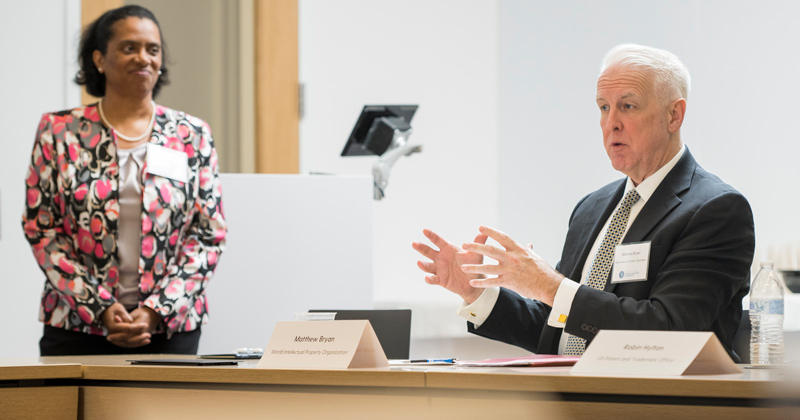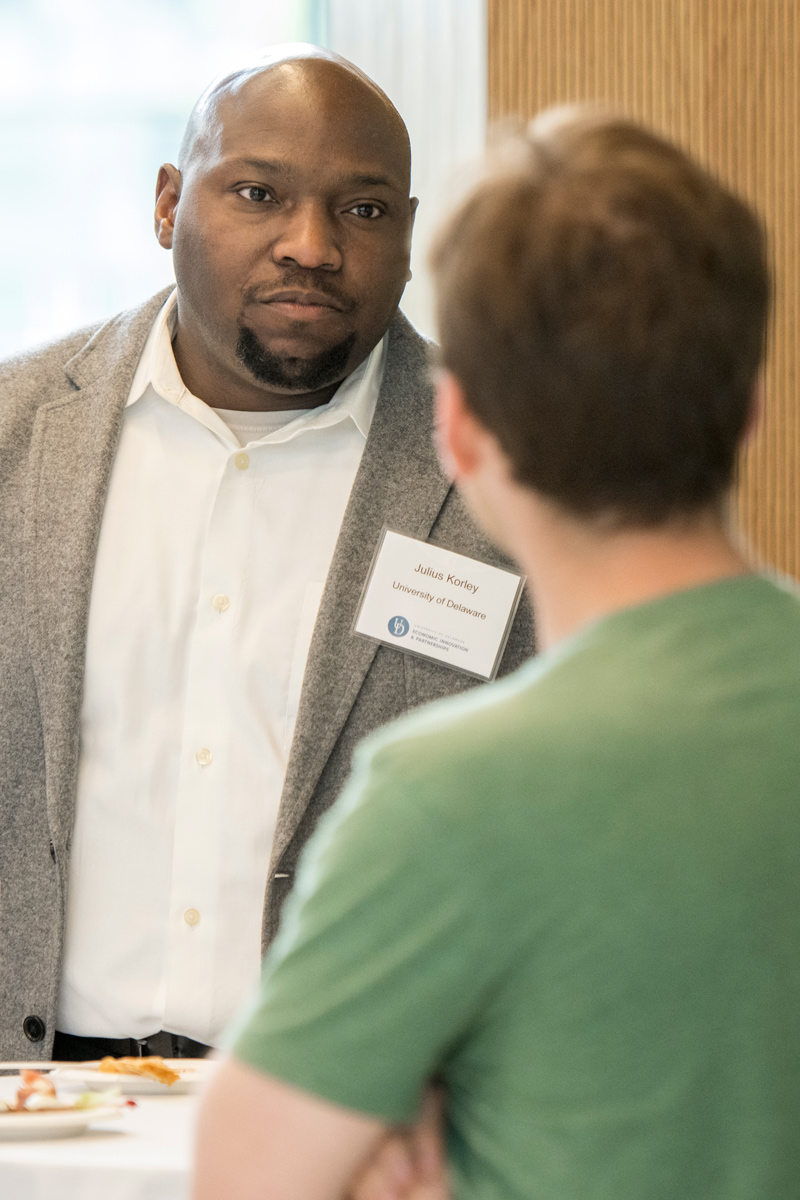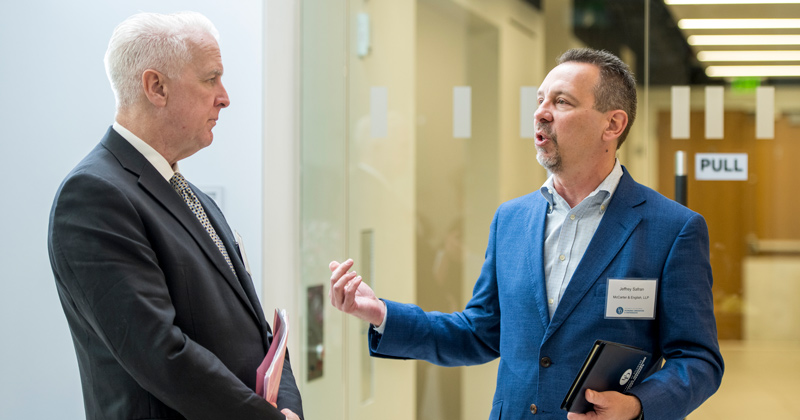


Protecting the value of brain power
Photos by Kathy F. Atkinson | Photo illustration by Jeffrey C. Chase May 15, 2023
Patent experts say international treaties, reckless delight can affect future of inventive ideas
As any inventor could tell you, the road to “Eureka!” often runs through significant financial investment, decades of research, exasperating detours, long monotonous stretches, a few scenic overlooks and failures of both minor and major proportions.
But arriving at the destination is thrilling indeed, a triumph that can be professionally and financially rewarding. Sometimes that new thing is worth more 20 years later than ever would have been predicted at the time of discovery.
That’s why intellectual property — the name given to inventive ideas, methods and products — is well worth protecting.
Two experts in the field of intellectual property and the patents that protect those creative advances — Matthew Bryan of the United Nations’ World Intellectual Property Organization and Robin Hylton of the U.S. Patent and Trademark Office — visited the University of Delaware on April 26 for a special seminar: “Change Is Coming. Learn Together.”

Leaders and specialists from UD’s Office of Economic Innovation and Partnerships (OEIP) along with several UD inventors and patent attorneys gathered for a wide-ranging discussion of international agreements, pain points in their use and best practices for submitting patent applications and navigating the processes, whether foreign or domestic.
With global collaboration and interdisciplinary work often features of new discoveries, the details of who owns a new technology and how to protect inventors’ interests can become complicated and fraught. The Patent Cooperation Treaty (PCT) process, adopted by 157 member states of the United Nations, is meant to help sort out those legal considerations. As a specialized agency of the United Nations, WIPO includes 193 member states, with 1,500 staff managing 26 intellectual property treaties.
Bryan, an attorney and an expert in navigating these international waters, is director of WIPO’s Patent Cooperation Treaty (PCT) Legal and User Relations Division.
“We are aware of the reputation of UD both as one of the oldest universities in the United States and as a research university and likewise as a user of both the U.S. patent system and the international patent system via the Patent Cooperation Treaty which WIPO administers,” Bryan said. “Coming to UD provided a good opportunity to get better acquainted and update interested colleagues in the Office of Economic Innovation and Partnerships about recent and future PCT developments and get direct feedback from UD as to how our system could be improved.”
Under the direction of Associate Vice President Julius Korley, OEIP is UD’s headquarters for researchers, innovators and inventors who want to put their ideas and new-fangled contraptions to work in their own startup companies or license them to other companies for use in new products.
“Having the opportunity to hear from and engage with patent experts with national and international perspectives gives us new insight and ideas for strengthening and expanding our work here at UD,” Korley said. “We want to have maximum impact. So it’s important to get these things right — important not only for our innovators and for economic development, but important for our world, which will benefit from the advances and solutions our researchers develop.”

Before 1980, patents emerging from federally funded research were automatically assigned to the federal government, wrapped in bureaucratic red tape and too often never seen or heard from again.
The Bayh-Dole Act, signed by President Jimmy Carter in 1980, aimed to correct that problem. Bayh-Dole gave universities, nonprofits and other businesses in the United States the right to patent intellectual property developed from federally funded research. The goal was to liberate such innovative ideas and inventions and see where they might go next.
They’ve gone a long way in the 42 years since then. A 2022 report by the Center for Strategic and International Studies said Bayh-Dole accounts for more than $1.3 trillion in economic growth, more than 4.2 million jobs and the success of more than 11,000 startup companies from universities around the nation.
In 1978, just two years before Bayh-Dole, the UN adopted the PCT system to help innovators in member states seek patent protection beyond their borders. Each PCT application has potential legal effect in all of the Treaty’s member states and after a standard procedure during which applicants learn about the likelihood that their invention will be patentable, applicants can seek protection in countries of interest to them.
Participation has grown steadily and last year 278,100 patent applications were filed, an increase of 0.3% from 2021. In the PCT’s 44 years, only 2009 — the year of the global financial crisis — saw a decline in such filings, Bryan said.
China leads the world in filing PCT applications. Last year, it filed about 70,000 applications. The U.S. was second with just under 60,000 and Japan was third with about 50,000. More than half of all applications came from Asia (54.7%). The greatest increase in applications in 2022 came from India (25.4%), Korea (6.2%) and France (5.9%).
China’s Huawei Technologies led all applicants with 7,689 applications in 2022, Korea’s Samsung was second with 4,387 and Qualcomm in the U.S. was third with 3,855.
Universities represent about 6% of all PCT applications, Bryan said.
The U.S. had five universities in the top 10 globally — with the University of California in the No. 1 spot, Stanford fourth, the University of Texas fifth, MIT seventh and Johns Hopkins eighth. China had three universities in the top 10 and South Korea had two.
The U.S. Patent and Trademark Office (USPTO) works with universities, small businesses and entrepreneurs to evaluate and process patent applications, ensuring that they meet legal requirements and explain clearly the new development that the inventor believes warrants legal protection.

In fiscal year 2022, the office had more than 13,000 employees, including more than 8,500 patent examiners organized by specific areas of expertise or training.
Hylton, assistant outreach coordinator for the USPTO’s Eastern Regional Outreach Office, is a civil engineer who has examined many patents, specifically those related to container closures, such as a gasoline cap, a child-resistant cap or a sippy cup.
She offered important advice for applicants.
One of the biggest challenges for a patent examiner when examining an application for a U.S. patent, Hylton said, is finding a clear explanation of the inventive concept. If it’s not clear, the examination process may be prolonged.
Examiners also have the tough job of evaluating the claims of the patent application. Claims form the “metes and bounds” — the boundary lines — of the invention. Applicants should strive for the claims to be sufficiently broad to cover the invention but also sufficiently narrow so that they don’t apply to more than the applicant is entitled to claim, she said.
Resources for attorneys, inventors and applicants are readily available on the web sites of both WIPO and the USPTO.
Attorneys and agents can get training to understand the process patent examiners use to evaluate applications, for example, Hylton said.
Asked what the USPTO would especially like researchers to know, Hylton had no hesitation.
“Don’t publicly disclose your invention without having some type of intellectual property protection in place,” she said. Premature disclosure undermines the protections available under patent law.
That means ensuring that students and faculty do not publish, post or otherwise declare their inventions and findings before they have entered that process of legal protection.
“Publication can constitute public disclosure,” Hylton said. “If you make an oral reference, an oral disclosure at a trade show, for example, you may have disclosed your invention publicly to such an extent that it can start a time clock affecting your ability to patent. And if it is done in a dissertation defense that could also possibly constitute a public disclosure.”
Harsh Bais, a UD inventor and professor in the College of Agriculture and Natural Resources, said many dissertation defenses now are recorded or posted online.
“Then it becomes public domain,” he said, “and students may not realize what that means. They may put it on social media and there you go.”
It is essential for advisers to let students know of these constraints, Hylton said.
About Intellectual Property Rights
According to the World Intellectual Property Office, rights attached to intellectual property include patents, copyright, trademarks, industrial designs, geographical indications and trade secrets. Specifically, these are defined this way:
Patent: Exclusive right granted for an invention that gives the owner the right to decide how or whether the invention can be used by others.
Copyright: Rights creators have over their literary and artistic works, including books, music, paintings, sculpture, films, computer programs, databases, advertisements, maps and technical drawings
Trademarks: A sign capable of distinguishing the goods or services of one enterprise from other enterprises.
Industrial designs: Ornamental or aesthetic aspect of an article – 3D or 2D (patterns, lines or color).
Geographical indications: Specific geographical origin and possess qualities essentially attributable to that place of origin.
Trade secrets: IP rights on confidential information which may be sold or licensed.
Contact Us
Have a UDaily story idea?
Contact us at ocm@udel.edu
Members of the press
Contact us at 302-831-NEWS or visit the Media Relations website

